Summary, abstracts and full texts of issue no. 113
Philippe Mesnard (Editor in chief): Editorial. Du sang, entre ciel et terre. À propos de nouvelles tendances de l’historiographie de la Shoah (pdf in French) (pdf in Dutch) [Blood between heaven and earth: on new tendencies in the historical study of the Shoah]
Portfolio Terezin / Theresienstadt (pdf in French and Dutch) (fotos: Philippe Mesnard)
Dossier: Les tabous de l’histoire allemande [The Taboos of German History]
Edited by Martine Carré, Ingeborg Rabenstein-Michel and Ralf Zschachlitz
Martine Carré (Jean Moulin University – Lyon 3), Ingeborg Rabenstein-Michel (Claude Bernard University – Lyon 1) et Ralf Zschachlitz (Lyon 2 University) : Présentation (pdf in French)
Emmanuelle Aurenche-Beau (Lumière University – Lyon 2): La mémoire de la fuite et de l’expulsion dans Niemandszeit de Jörg Bernig (2002) et Die Unvollendeten de Reinhard Jirgl (2003) (pdf)[Memories of flight and expulsion in Niemandszeit by Jörg Bernig (2002) and Die Unvollendeten by Reinhard Jirgl (2003)]
- After having been more or less kept under cover in the former GDR, flight and expulsion are the central themes in two novels published in the first decade of the 21st. century and written by two authors from former East Germany, both the grandsons of former Sudeten German families. Their books have certain points in common which distinguish them from works published in earlier decades (a strong historical basis, an attempt to go beyond a dualistic opposition between victim and executioner), but show similar ways of handling the subject of flight and expulsion by members of a generation which did not live through these events. Bernig has clearly chosen the path of fiction by setting the action of his novel in a place without a name which serves as a sort of experimental example of a possible shared life between Czechs and Germans, while Jirgl attempts to reconstitute the history of four generations of his family.
Carola Hähnel-Mesnard (Charles de Gaulle University – Lille 3): La mémoire de la fuite et de l’expulsion chez Hans-Ulrich Treichel et Reinhard Jirgl – distanciation ou victimisation?(pdf)[How Hans-Ulrich Treichel and Reinhard Jirgl remember flight and expulsion – distancing or victimization?]
- The article examines the representation of the flight and expulsion of Germans from territories in the East at the end of the war in two contemporary literary works, Der Verlorene by Hans-Ulrich Treichel (1998), and Die Unvollendeten by Reinhard Jirgl (2003). While the subject does not constitute a taboo per se, having found its way into literature from 1945, the familial and emotional dimensions that characterize the return to this subject today merit examination. The two works, written by authors whose families were affected by these historical events and who both belong to the second generation, address the subject in very different ways. Treichel’s novel uses narrative and stylistic procedures to keep the suffering of the German population at a distance and recalls the Jewish genocide by adding a reflection on German actions and responsibility. Jirgl’s novel, on the other hand, presents a typical German victim who carries the traits of the archetypal victim, and casts doubt on the idea of calling history into question.
Delphine Klein (Jean-Monnet University – Saint-Étienne): De l’abus à l’affût des tabous. Ulrike Maria Stuart d’Elfriede Jelinek (pdf)[From abuse to lying in wait for taboos: Ulrike Maria Stuart, by Elfriede Jelinek]
- In her play Ulrike Maria Stuart, written in 2005, Elfriede Jelinek, a highly controversial playwright despite her 2004 Nobel Prize for literature, calls on the voices of terrorists from the German Red Army Faction, an episode in Germany’s recent history which was surrounded by taboos. An analysis of her handling of her historical subject shows how Elfriede Jelinek is able to invoke the memory of a poorly healed wound from the past and question the workings of memory. The author not only confronts the taboos of history and deconstructs myths, but also makes war on the taboos surrounding the practice of writing for the stage. She compares traditional theatrical conventions with a style freed from all constraints, which commits the supreme sacrilege of using and sabotaging a canonical text of Germany’s literary and cultural heritage, Maria Stuart by Friedrich Schiller. But does this type of writing have an impact in the end, or does its attempt to express the inexpressible and free what has been repressed result only in impenetrability and an excess of meaning?
Ingeborg Rabenstein-Michel (Claude Bernard University – Lyon 1): Adolf Hitlers Mein Kampf, gezeichnete Erinnerungen an eine große Zeit: Kurt Halbritter et la déconstruction du tabou du suiveur par et dans la BD (pdf)[Adolf Hitlers Mein Kampf, gezeichnete Erinnerungen an eine große Zeit: Kurt Halbritter and the deconstruction of the follower taboo by and in graphic books]
- In Adolf Hitlers Mein Kampf: gezeichnete Erinnerungen an eine groBe Zeit, Halbritter aims to denounce the taboo on discussing Nazi fellow-travelers which has been and still is so strong in Germany. By choosing in 1968 the comic book form, a genre considered minor and even subversive, to record the chronology of daily life under the Third Reich from Hitler’s accession to the fall of the regime (thus anticipating the principle of the graphic novel), he adds an additional dimension to his provocation. Bearing in mind the surveys of German students which unveiled the extent of their ignorance of this part of their recent and disturbing history, Halbritter’s satire may also be read as a salutary didactic undertaking which goes against the voluntary interruption in the transmission of History practiced during their parents’ generation. In preparation for 2016, when Mein Kampf will fall into the public domain, it may be useful to recall Halbritter and his unusual and rather iconoclastic appeal to confront the past.
Martine Carré (Jean Moulin University – Lyon 3): Quand un tabou en cache un autre: Tod eines Kritikers – Mort d’un critique de Martin Walser (pdf)[When one taboo hides another: Tod eines Kritikers – Death of a Critic by Martin Walser]
- Martin Walser’s novel Tod eines Kritikers both announces and denounces the debate it triggers. The article shows that its restrictive structure invites the reader to question the taboo on antisemitism in Germany in the 90s. Can the taboo be considered as a “screen taboo” which aims to conceal another taboo, that of a “mortgaged freedom of reflection” in the democracies of communication through the coercive power of opinion as shaped by the media (here a type of collective guilt)?
Sibylle Goepper (IEP Strasbourg): La judéité dans les romans de Barbara Honigmann et Jan Faktor: tabou dépassé, identité refondée (pdf)[Jewish identity in the novels of Barbara Honigmann and Jan Faktor: taboo transcended, identity recreate]
- For over 40 years the Jews of the GDR lived through a paradoxical situation: welcomed as “victims of Fascism” they benefited from privileges, but at the same time were forced to remain silent about their origins. Among writers, eminent personalities accepted this concealment. This was the case until the 1990’s, when they began to return to their Jewish roots. Barbara Honigmann (born 1949), a daughter of Jewish Communists who had escaped the Shoah, returns to this taboo in her novels. They make it clear that the “generation of survivors” agreed to the renunciation involved in order to prove their loyalty to the regime. They also illustrate the problems which affect not only the children of survivors, but more especially their children, who have inherited an empty shell of family history. The reference to Judaism is recent in the works of Jan Faktor (born 1951), and is intrinsically linked to his passage to prose in the first decade of the 21st century. His novels deal essentially in a humorous way with, the concentration camp experience of the women in his family. Honigmann and Faktor share a quest for identity in their writing, and both offer an authentic and optimistic synthesis between historical periods, generations, cultures and systems.
Hélène Camarade (Michel de Montaigne University – Bordeaux 3): Le viol des femmes allemandes en 1944-1945: Un tabou transgressé dans les journaux intimes et les romans? (pdf)[The rape of German women in 1944-1945: a taboo transgressed in personal diaries and novels?]
- It would not be correct to claim that the taboo concerning the rape of German women in 1944-45 was only broken in Germany during the last decade. In the former GDR there was a political taboo on the subject, but it was already broken during the second half of the 1970s (Christa Wolf, Werner Heiduczek). After a period of silence ending in 1959, the rapes were referred to in the German Federal Republic, both in novels, (Günter Grass, Edgar Hilsenrath) and in written and orals testimony, films and political speeches. Even today, however, references to the rapes still seem to respect certain narrative conventions, which raise the question of whether those conventions are not due to the fact that the victims’ voices were not heard, rather than because the events themselves could not be expressed. In diaries (Anonyma/Marta Hillers, Hans von Lehndorff, Käthe von Norman, Ruth Andreas-Friedrich, Ursula von Kardorff), these narrative conventions mainly consist of preserving the anonymity of the victims, referring to the text via a third party, giving the subject only marginal importance and using circumlocutions as euphemisms. Authors of contemporary novels (Hans-Ulrich Treichel, Jlia Franck, Gudrun Pausewang) favor the child’s viewpoint, thus making it possible to raise the effects of the taboo on families.
Anne Peiter (Réunion University): À la recherche d’un champ anhistorique. Mise en place de tabous allemands: les exemples de Leni Riefenstahl et Albert Speer (pdf)[In search of an ahistorical field: the establishment of German taboos; the examples of Leni Riefenstahl and Albert Speer]
- The contribution examines the ways in which the photographer and film director Leni Riefenstahl and Hitler’s armaments minister Albert Speer perceived the Nazi past when the taboo process, or rather the “de-tabooing” process, was set up after 1945 in West Germany. In general, German political memory evolved from collective silence to progressive recognition of Germany’s crimes, but Speer and Riefenstahl did not follow this evolution. Their names were banned until the 1960s, when they gained notoriety due to their “journeys”. Speer went round the prison garden in circles like a man obsessed, and called this circling “a journey around the world”. Riefenstahl brought back photographs from the Sudan which gave a new impetus to her career, while at the same time taking her back to the past, all the way back to the Third Reich. In Riefenstahl’s view, it was not the past which cast light on the succeeding period, but the present which cast light on a past in which she saw only pure, apolitical and ahistorical beauty. Speer was more inclined to confront the past via self-questioning. But it may be asked whether in fact he too did not aim at purifying the present, and thus, like Riefenstahl, reconciling past and present under the sign of purity. “De-tabooing” thus signifies an encouragement to turn the page and file the Shoah away.
Ralf Zschachlitz (Lyon 2 University): Tranches de vie sous le national-socialisme marquées du sceau du tabou dans Anders de Hans-Joachim Schädlich, Demenz de Tilman Jens et Beim Häuten der Zwiebel de Günter Grass (pdf)[Slices of life under National Socialism marked by the seal of the taboo in Anders by Hans-Joachim Schädlich, Demenz by Tilman Jens and Beim Häuten der Zwiebel by Günter Grass]
- Sixty years after the end of the Third Reich, a number of German literary works focus on biographies affected by the taboos and physical repression surrounding Germany’s twelve darkest years. Ralf Zschachlitz presents three biographical or autobiographical works which deal with the taboos woven around three characters who played important roles in the intellectual and cultural life of post-war Germany. “Anders”, a work by Hans-Joachim Schädlich, looks at the falsified biography of Hans Schneider, alias Hans Schwerte, professor of literature at Aachen University and former SS member. “Demenz” by Tilman Jens, son of the distinguished professor of rhetoric Walter Jens, relates how his father's hitherto concealed membership of the National Socialist party came to light In his autobiographical work “Beim Häuten der Zwiebel”, Nobel prize-winner Günter Grass revealed that he had been a member of the Waffen-SS, while attempting to minimize this fact.
Other
Dr. Fabian Van Samang (Historian): “Elke handeling met de intentie te vernietigen…”. Inhoud en limieten van het concept genocide in het proces tegen Ratko Mladić(pdf) [“Any of the following acts committed with intent to destroy...”: the content and limits of the concept of genocide in the trial of Ratko Mladić]
25 ans après sa disparition. Ce qu’a vraiment dit Levi (pdf)[25 years after his death: what Levi really said]
Bookstore (pdf of Book reviews)
- Bernard Bruneteau, Le Totalitarisme. Origines d’un concept, genèse d’un débat (1930-1942), Paris, Cerf, 2010. [Totalitarianism: origins of a concept, genesis of a debate]
Review in French by Anne Roche (Aix-Marseille University)
- Bernard Bruneteau, L’âge totalitaire. Idées reçues sur le totalitarisme, Paris, Le Cavalier Bleu, 2011. [The totalitarian age: conventional ideas on totalitarianism]
Review in French by Nancy Berthier (Sorbonne University – Paris IV)
- Philippe Mesnard, Primo Levi. Le passage d’un témoin, Paris, Fayard, 2011. [Primo Levi: the passage of a witness]
Review in French by Frediano Sessi (Mantova University)
- Philippe Mesnard, Primo Levi. Le passage d’un témoin, Paris, Fayard, 2011.
Enrico Mattioda, Levi, Rome, Salerno, 2011.
Review in French by Albert Mingelgrün (President of the Fondation de la Mémoire Contemporaine)
- Enzo Traverso, L’histoire comme champ de bataille. Interpréter les violences du XXe siècle, Paris, La Découverte, 2011. [History as a battlefield: interpreting violence in the twentieth century]
Review in French by Frediano Sessi (Mantova University)
- Guy Penaud, L’Inspecteur Pierre Bonny. Le policier déchu de la “Gestapo française” du 93, rue Lauriston, Paris, L'Harmattan, 2011.
Review in English by Sash Lewis
- Gérard Haddad, Lumières des astres éteints. La psychanalyse face aux camps, Paris, Grasset, 2011. [Light from extinct stars: psychoanalysis in light of the camps]
Review in French by Michel Enaudeau (Journalist)
- Philippe Masson, Histoire de l'armée allemande, 1939-1945, Paris, Perrin, 2010. [History of the German army]
Review in French by Leonore Bazinek (Rouen University)
- Anne Roche, Exercices sur le tracé des ombres. Walter Benjamin, Paris, Grasset, 2011. [Exercises on the track of shadows]
Review in French by Carola Hähnel-Mesnard (Charles de Gaulle University – Lille 3)
The journal is available on line at
openedition.org
All issues
-
No. 138 (04/2024) Trials
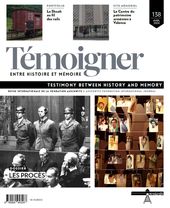
This dossier will deal with trials that have provided a legal answer to a demand for justice. Several cases will be addressed ranging from Istanbul and the Nuremberg Doctors' trial to the German policemen of the Brussels Jewish section and the gacaca trials in Rwanda.
Table of contents (Dutch version)
Table of contents (French version)No. 137 (10/2023) Children's Literature in Light of the Holocaust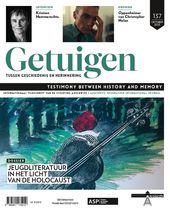
In France and Belgium, research into the relationship between children's literature and the Holocaust is rare, in contrast to the phenomenal attention in America (everyone knows Art Spiegelman's Maus) and in other English-speaking countries. Yet children's books depicting the Holocaust in words and pictures have been steadily gaining ground in post-war France and Belgium. While literary criticism and research still seem to be in their infancy, this dossier will show that critical analysis of this corpus is highly relevant for the future.
Table of contents (Dutch version)
Table of contents (French version)No. 136 (04/2023) The Executioners
The executioner has always fascinated and frightened. The perpetrators of mass crimes are those who carry out, facilitate or order the annihilation of a specific group. Issue 100 of Testimony: Between History and Memory, published in September 2008, examined the Nazi executioners. This dossier offers readers a historical and criminological approach to other genocides of the 20th century.
Table of contents (Dutch version)
Table of contents (French version)No. 135 (10/2022) Disobedience
This issue looks at the concept of disobedience in wartime. While the concept of civil disobedience may seem familiar in these times of endemic protest, there was a time when obedience was the rule. In a military context, disobedience was frequently followed by deadly consequences. This dossier focuses on three cases from the First World War and one from the Algerian War (1954-1962).
Table of contents (Dutch version)
Table of contents (French version)No. 134 (04/2022) The Killing of the ‘Useless’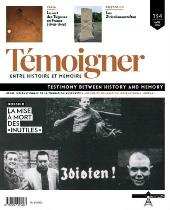
During the Second World War, the Nazi regime didn't just try to destroy the Jewish "race", which it considered dangerous. Before implementing the Final Solution, the Nazis massacred those who didn't fit in with their eugenic racial ideology and whom they considered inferior. In this dossier, we focus on the mentally and physically handicapped, systematic victims of Nazi pseudo-medical madness throughout the world conflict.
Table of contents (Dutch version)
Table of contents (French version)No. 133 (10/2021) 1918-1938: The politicisation of music in Europe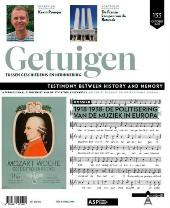
1918-1938: The politicisation of music in Europe
This dossier looks at the instrumentalisation of music by the political world between the wars. The cases are numerous and shed light on the way in which political propaganda was propagated in European musical culture.
Table of contents (Dutch version)
Table of contents (French version)No. 132 (04/2021) AKTION REINHARDT and AKTION ERNTEFEST
AKTION REINHARDT and AKTION ERNTEFEST
The Aktion Reinhardt saw approximately 1.8 million Polish Jews perish in the gas chambers of Bełżec, Sobibór, Treblinka and Majdanek between March 1942 and November 1943. The Jews who ‘escaped’ the gas chambers were shot in Majdanek, Trawniki and Poniatowa on 3 and 4 November 1943 during Aktion Erntefest. The dossier we are proposing takes stock of current research on the Aktion Reinhardt. This historical event has experienced a resurgence of interest among historians of the Shoah over the last fifteen years, thanks, among other things, to archaeological advances at the various sites concerned. We have come a long way since Yithzak Arad's pioneering work in 1987: Belzec, Sobibor, Treblinka: the Operation Reinhard Death Camps. The dossier highlights different perspectives to discuss current research related to the issue. It addresses the erasure of traces, the sociological perspectives of the executioners, the excavation of extermination sites and the most recent historiography.
Table of contents and abstracts (Dutch version)
Table of contents and abstracts (French version)No. 131 (10/2020) Historiography of the Second World War in the Far East
Historiography of the Second World War in the Far East
For many people, 8 May 1945 and the surrender of Nazi Germany is the final chapter of the Second World War. However, it is often forgotten that the months between May and September 1945 were decisive for the future of the world, as fierce fighting continued in the Pacific between the United States and the Japanese Empire until the latter’s unconditional surrender on 2 September 1945, the actual date of the end of the Second World War.Table of contents and abstracts (Dutch version)
Table of contents and abstracts (French version)No. 130 (04/2020) Reception of the Shoah and mentalities in Jewish and Christian circles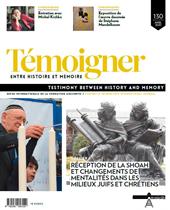
Reception of the Shoah and mentalities in Jewish and Christian circles
The reception of the Shoah has become, for all of humanity, a place of questioning and awareness. This dossier will aim to establish and evaluate the modalities and challenges of the transmission of the Shoah and to measure the resulting changes in identities and mentalities. What were the Catholic views on Judaism before and during the Shoah? What Jewish liturgies and interreligious rites exist for the commemoration of the Shoah in Israel and the United States? The evolution of mentalities in the Jewish world in relation to the Shoah will also be exposed through the analysis of the so-called Bitburg controversy, triggered by the visit of the American President, Ronald Reagan, to the German military cemetery of Bitburg (FRG) in May 1985. The Auschwitz Carmel affair (1985-1993) finally reveals the involvement of the Belgian and French Churches in the resolution of the conflict and is undoubtedly a key stage in the Church's 'teaching of esteem' with regard to the Jews. The historical answers provided in this dossier to the question of the Shoah may be decisive for the survival of Judaism and the relationship between Judaism and Christianity.
Table of contents and abstracts (Dutch version)
Table of contents and abstracts (French version)No. 129 (10/2019) Recognition of victims
Recognition of victims
In recent decades, the idea has gained ground that victims of mass crimes deserve recognition. This has become an essential category of our memorial culture. This dossier aims to take stock of this issue by looking at the broad spectrum of measures to ensure recognition, from simple remembrance to targeted judicial interventions, and by recalling the growing importance of the victim in international criminal justice. It returns to the problematic aspects of recognition when it leads to competition among victims.
Table of contents and abstracts (Dutch version)
Table of contents and abstracts (French version)No. 128 (04/2019) 25 years on, how to remember the Tutsi genocide
Kwibuka [Remember]. 25 years on, how to remember the Tutsi genocide
April 1994. Images of mutilated bodies are projected on European screens, originating from Rwanda. 25 years later, we remember.Table of contents and abstracts (Dutch version)
Table of contents and abstracts (French version)No. 127 (10/2018) Perpetuation of violence after 1918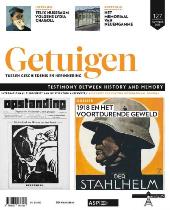
Perpetuation of violence after 1918
One hundred years ago, the First World War ended in November 1918. After four years of bloodshed, peace returns to Europe. At least, that was the impression of the victors at the time, and today it is also the impression of the commemorators who celebrate its centenary. The historical reality is more complex. At least until 1923, violence continued in the form of revolutions and counter-revolutions, wars and civil wars. The spirits also remain in the grip of violence on both the left and the right. The dossier proposes to define the contours of this Europe so strongly marked by the Great War, by evoking the culture of violence established by it and which, finally, degenerated into the total explosion of the Second World War.
No. 126 (04/2018) Questions about the future of remembrance work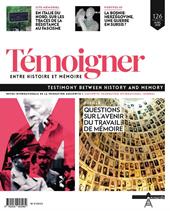
Questions about the future of remembrance work
On 20 and 21 January 2017, the seminar ‘Questions on the future of remembrance work’ was held in Esch-sur-Alzette, Grand Duchy of Luxembourg. The five articles in this dossier taken from the conference proceedings attempt to answer the following questions: How can we build a critical memory of the Shoah, free of myths and national fragmentation? How do we anticipate the absence of direct witnesses? In the future, who transmits what, and how?
No. 125 (10/2017) Persecution of homosexuals by the Nazis
Persecution of homosexuals by the Nazis
Historical knowledge of the Nazi persecution of homosexuals and their deportation has made significant progress in recent years due to the increase in research on the subject. In this dossier, recognised researchers as well as young doctoral and PhD students take the floor. The insights they provide concern both the question of the singular destiny of homosexual men and women during the Second World War and the way in which the memory of the homosexual victims of Nazism has evolved since the end of that war.
No. 124 (04/2017) Music in the camps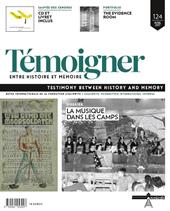
Music in the camps
Music was an integral part of the concentration camp world, Nazi and otherwise. What kind of music was composed and performed, and what exactly was its role in the camps? A factor of survival and resistance for the prisoners, a way for them to express their hope and their humanity - or, on the contrary, an instrument of oppression exploited by the executioners? What is the function of music in the work of memory following the experience of extreme violence and suffering? This dossier proposes to explore these issues.
No. 123 (10/2016) Translating Memory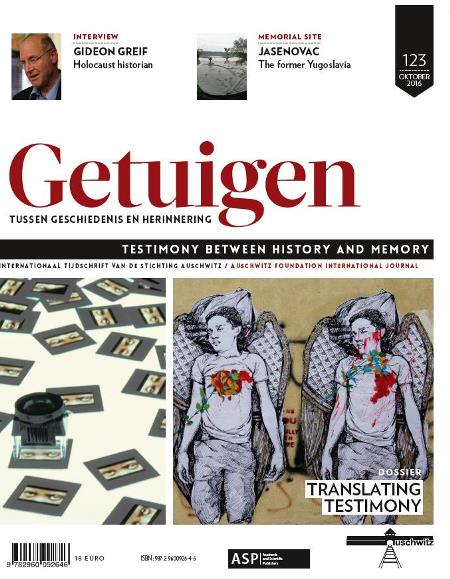
Translating Memory
Presentation of the dossier: What is the relationship between testimony, defined as a more or less ritualized firstperson account of political violence, and translation? Correspondingly, how does the translator position herself towards the witness? Can the translator be, or become, a witness? How, when and why are testimonies translated? Which linguistic and discursive strategies do translators resort to when faced with ethically challenging texts? Which role do they play exactly in the transmission of the historical knowledge, cultural values or social critique conveyed by the testimony? Does translation weaken or rather reinforce the relevance and impact of the original statement? How important is translation in literary, political and institutional settings? Do these specific settings determine translation practice in significant ways? To which extent can subsequent processes of transcription, editing, translation and archiving affect the source text? And how accurate are the boundaries we draw to distinguish witnessing from translating, documentary from literary testimony, the original from its translation? These are the main questions we intend to explore in our dossier.
No. 122 (04/2016) Revisionism and negationism
Revisionism and negationism
Strictly speaking, Holocaust denial is the ‘doctrine denying the reality of the Nazi genocide of the Jews, including the existence of the gas chambers’; by extension, the term refers to the denial of other genocides and crimes against humanity. The literature on Holocaust denial is extensive. There are studies on the subject in many countries as well as biographies of deniers. The argumentative and rhetorical strategies of the deniers have been widely deciphered. Websites systematically dismantle their fallacies. While there is no shortage of reliable information on the phenomenon, it is essential to return to it again and again, for several reasons.
No. 121 (10/2015) Extreme violence on stage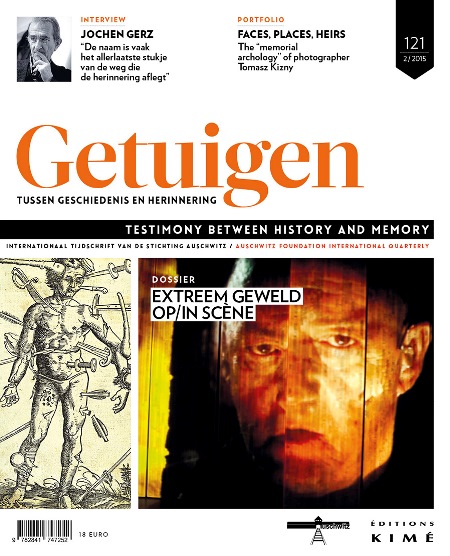
Extreme violence on stage
Extreme violence shows itself. It bursts through the screens. It surfs from one style and medium to another: news reports, documentaries, fiction, arts of all kinds. Yet theatre distinguishes itself from this mêlée all while constantly returning to the subject. Differently. Linked from its origins to the representation of cruelty and having “miraculously” escaped the often sterile polemics on the interdiction (or not)... of representing the Holocaust, it is still with the same youthfulness that theatre deals with extreme violence today, relentlessly pursuing the articulation of ethics and aesthetics.
No. 120 (04/2015) What future is there for the memory of the Armenian genocide?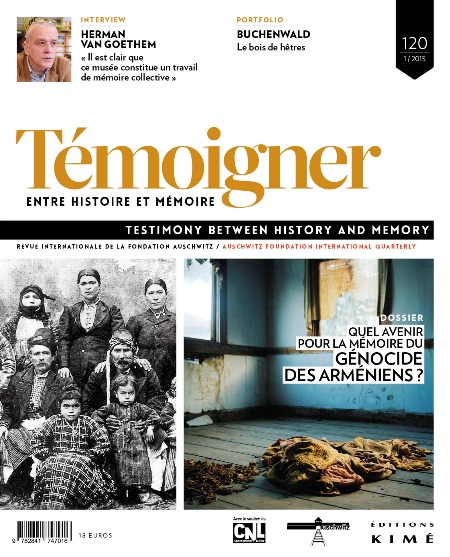
What future is there for the memory of the Armenian genocide?
The 1915 genocide of Turkish Armenians still stirs up numerous debates, controversies, declarations of principle, statements and counter-statements, and even negation. However, as we speak, ties are being established more and more openly, bridges are built and bonds strengthened between the Armenian and Turkish communities. Is reconciliation possible?
No. 119 (12/2014) 70 years ago, Auschwitz. Looking back on Primo Levi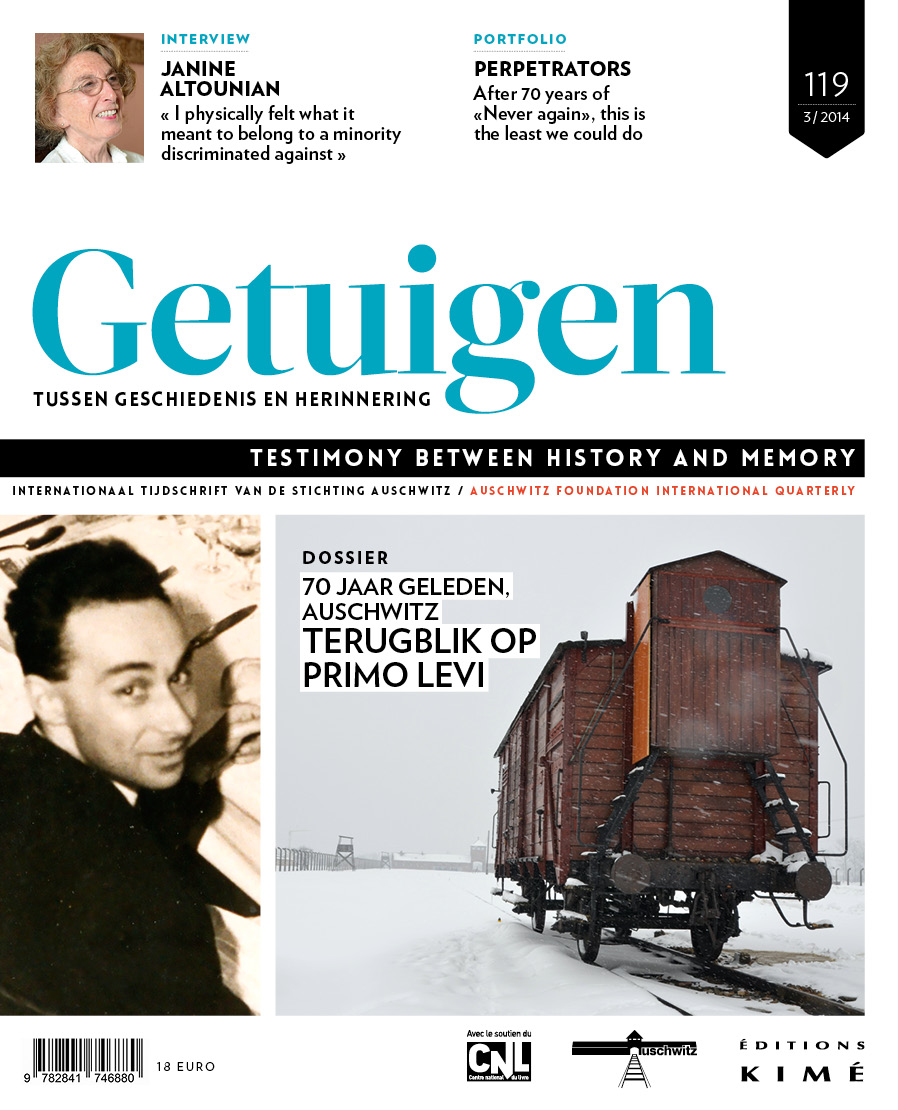
70 years ago, Auschwitz. Looking back on Primo Levi
27 January 1945. Seventy years ago the first soldiers of the Red Army marched into Auschwitz. One might argue that the camp was “liberated” then, but the truth is that neither Auschwitz, nor any of the other Nazi camps, was ever a priority to the Allied Powers. Primo Levi was one of the few survivors who knew how to hide and escape the enforced evacuation of the camps. With this dossier, we want to cast light on the complex figure that Levi was: a Jew, a deportee, a chemists, a witness, and a writer. It sets out to study his oeuvre and his interpretation of the notions of “resistance” and “engagement”, in order to understand how he eventually became a “professional survivor”, as he once described himself.
No. 118 (09/2014) Dictatorship and terror in Argentina, Chile and Uruguay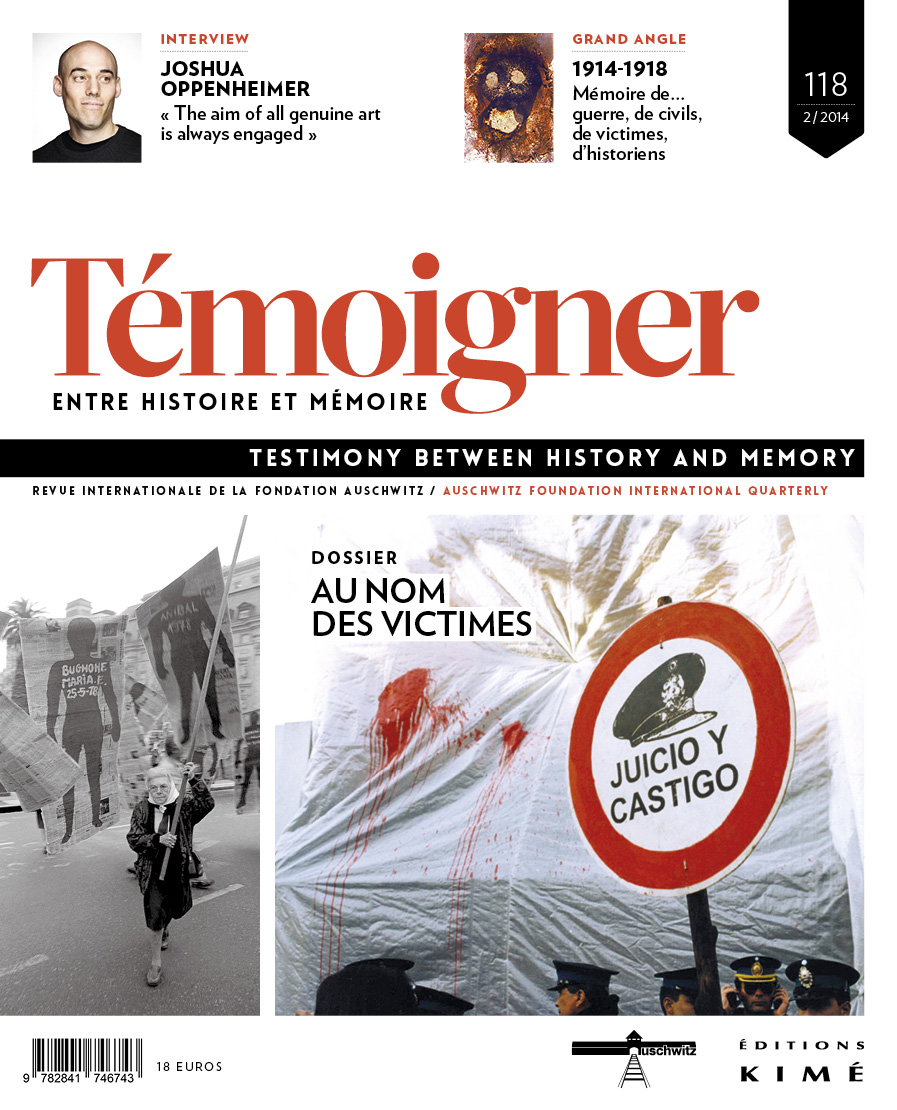
In the name of the victims. Dictatorship and State terror in Argentina, Chile and Uruguay
During the 1970s and 1980s, Argentina, Chile and Uruguay were in the grip of military dictatorships. The process of democratic transition that followed the long period of state terror involved the construction of particular narratives and memories, leading to a reconfiguration of the past. Despite local differences, this process is very much centered at the figure of the victim – a figure the articles in this dossier, collected by Claudia Feld, Luciana Messina and Nadia Tahir, set out to explore.
No. 117 (03/2014) Friends? Enemies? Relationships between memoriesAmis ? Ennemis ? Relations entre mémoires / Vriend of vijand? Hoe herinneringen zich tot elkaar verhouden [Friends? Enemies? Relationships between memories]
Much has been said and written about group memories, limiting their mutual relationships and history to conflicts, “wars”, competitions, or strategies for eclipsing or silencing. These terms have now become the platitudes of a kind of more general doxa about collective and cultural remembrance. This dossier proposes a critical reading of those terms and of that doxa by questioning the emergence, constitution, and inter-relating of different exemplary memories of the major violent episodes of the 20th century. It will address the relationships that those memories can maintain with other memories with which they share, if not the same event, at least similar characteristics and concerns.
No. 116 (09/2013) Memory tripsVoyages mémoriels / Herdenkingsreizen [Memory trips]
Should we fear what has been grouped under the term “memorial tourism”? Or should we take this as a reality of our time? Can any visitor, group or individual, nowadays be absorbed in the category of “tourist”? Or is this category a remote intellectual reduction of a personal experience that everyone is aiming during his visit? The problem appears in a somewhat different light when we think of tours for young people supervised by adults, usually teachers. This dossier gives the floor to historians and teachers with experience in the field.
No. 115 (03/2013) Memory construction in SpainL’Espagne en construction mémorielle / Spanje en de opbouw van de gedachtenis [Memory construction in Spain]
This dossier’s objective is to provide a benchmark for understanding the plural identities and relationships between memories and representation forms in contemporary Spain. Indeed, it is necessary today to take a fresh look not only on the stratified memories of the civil war, exile and the Franco repression, but also on the reception of other memories such as that of the Holocaust, and to propose new readings. We propose to highlight the conflicting or fruitful tensions between official actions, initiatives of associations and of artistic events.
No. 114 (12/2012) Memorial SitesSites mémoriels / Gedenkplaatsen [Memorial Sites]
Memorial sites constitute the concrete trace of European remembrance and history of the twentieth century. But what do they look like today? Exhibition and conservation criteria have changed during the last ten to fifteen years, like advances in historical research have changed the way we read and reconstruct past events. This is not only due to the fact that we have moved from a past history written by witnesses to a history written by professional historians. A new consciousness has emerged concerning transmission methods (memory education), and archeology has strengthened historical research. We tore off the veil of ideology that often influenced and prescribed the way we imagined permanent exhibitions, conservation and visits. Can we say we have entered a new era in memory transmission? It remains, in many ways, an open bet on the present and the future.
No. 113 (09/2012) The Taboos of German HistoryLes tabous de l'histoire allemande / De taboes van de Duitse geschiedenis The Taboos of German History]
The most painful or ambiguous periods in twentieth-century German history are characterized by numerous taboos, expressed in literature, photography and film as so many “returns of the repressed”. These studies focus in part on problems of antisemitism, and thus on the relationship of German-speaking societies to the Shoah. They also examine the way in which those societies confronted the violence they suffered, such as bombing, fleeing from the Red Army and the expulsions, and mass rapes.
No. 112 (06/2012) Children of the Spanish Civil WarLes enfants de la Guerre d'Espagne. Expériences et représentations culturelles / De kinderen van de Spaanse Burgeroorlog. Ervaringen en culturele voorstellingen [Children of the Spanish Civil War: Experiences and Cultural Representations]
The dossier in this issue deals with the experiences and cultural representations of childhood during the Spanish Civil War. It aims to help towards a better understanding of that conflict, which tore apart a population living on the same territory, by confronting the experiences of Spanish children who lived through it – as expressed in various forms during or after the war – with representations of those same children, particularly those coming from adults.
No. 111 (12/ 2011) Dangerous Game between Art and PropagandaArt & propagande : jeux inter-dits / Gevaarlijk spel tussen kunst en propaganda [Dangerous Game between Art and Propaganda]
Since the media came into existence, political institutions from political parties to governments have used them to promote their image, in order to win the support of the public they addressed. Authoritarian powers use the media as a means of consolidating their domination. But how can artists take part in propaganda, whose purposes are the opposite of those generally attributed to art? Does that mean setting aside their vocation, or do they themselves distort that vocation?
No. 110 (10/2011) Displacements, Deportations, ExileDéplacements, déportations, exils / Volksverhuizingen, deportaties, verbanningen [Displacements, Deportations, Exile]
States and criminal groups exploit population displacements to isolate or get rid of certain populations. In addition to being denied their normal rights, these populations lose visibility and are deprived of their reference points and social frameworks. In this way it is possible to make them the victims of constraints (deterritorialization, forced labor…) or violence (famine, massacres genocide…). These developments have spread on an unprecedented scale since the First World War and continue to grow worldwide. But there is also a dimension of remembrance to this reality: memories of these displacements are now being expressed in literature, and in exhibitions and museums. This dossier examines the contemporary double aspect of history and memory.
No. 109 (03/ 2011) 20th Century Wars and Genocides in Graphic Novels and Comic StripsLa bande dessinée dans l'orbe des guerres et des génocides du XXe siècle / Twintigste-eeuwse oorlogen en genociden in het stripverhaal [Twentieth Century Wars and Genocides as Portrayed in Graphic Novels and Comic Strips]
No. 108 (09/2010) How Documentaries Handle HistoryLe traitement de l'histoire dans les documentaires filmiques / De behandeling van de geschiedenis in de documentaire film [How Documentaries Handle History]
No. 104 (09/2009) Anti-fascism Revisited: History, Ideology, RemembranceL'Antifascisme revisité. Histoire – Idéologie – Mémoire / Nogmaals antifascisme. Geschiedenis, ideologie, gedachtenis [Anti-fascism Revisited: History, Ideology, Remembrance]
No. 103 (06/ 2009) Nazi Crimes and Genocides on the ScreenCrimes et génocides nazis à l'écran / Nazimisdaden en genociden op het scherm [Nazi Crimes and Genocides on the Screen]
No. 102 (03/ 2009) The Portrayal of Political Criminals in Films, Plays, Literature...Criminels politiques en représentation. Arts, cinéma, théâtre, littérature, médias / De representatie van politieke misdadigers. Kunst, film, theater, literatuur, media [The Portrayal of Political Criminals in Films and Plays, in Literature and in the Media]
No. 101 (12/2008) How to Educate, How to Remember?Quelle pédagogie, pour quelle(s) mémoire(s) ? / Welke pedagogie, voor welke herinnering(en)? [How to Educate, How to Remember?]
No. 100 (09/2008) Questions about the “Executioners”Questions de « bourreaux » / De kwestie van de “beul” [Questions about the “Executioners”]
Contact
Auschwitz Foundation – Remembrance of Auschwitz
Rue aux Laines 17 box 50 – B-1000 Brussels +32 (0)2 512 79 98
+32 (0)2 512 79 98 info@auschwitz.be
info@auschwitz.be
BCE/KBO Auschwitz Foundation: 0876787354
BCE/KBO Remembrance of Auschwitz: 0420667323
Office open from Monday to Friday 9:30am to 4:30pm.
Visit only by appointment.![]()
![]()
![]()
![]()
Become a member
To become a member of Remembrance of Auschwitz ASBL, take part in its activities and support its actions, please contact us.
Membership costs €40.00, payable to account n° 310-0780517-44 (IBAN : BE55 3100 7805 1744 – BIC : BBRUBEBB)
Donations of more than €40.00 qualify for a tax exemption for Belgian tax-payers.








































